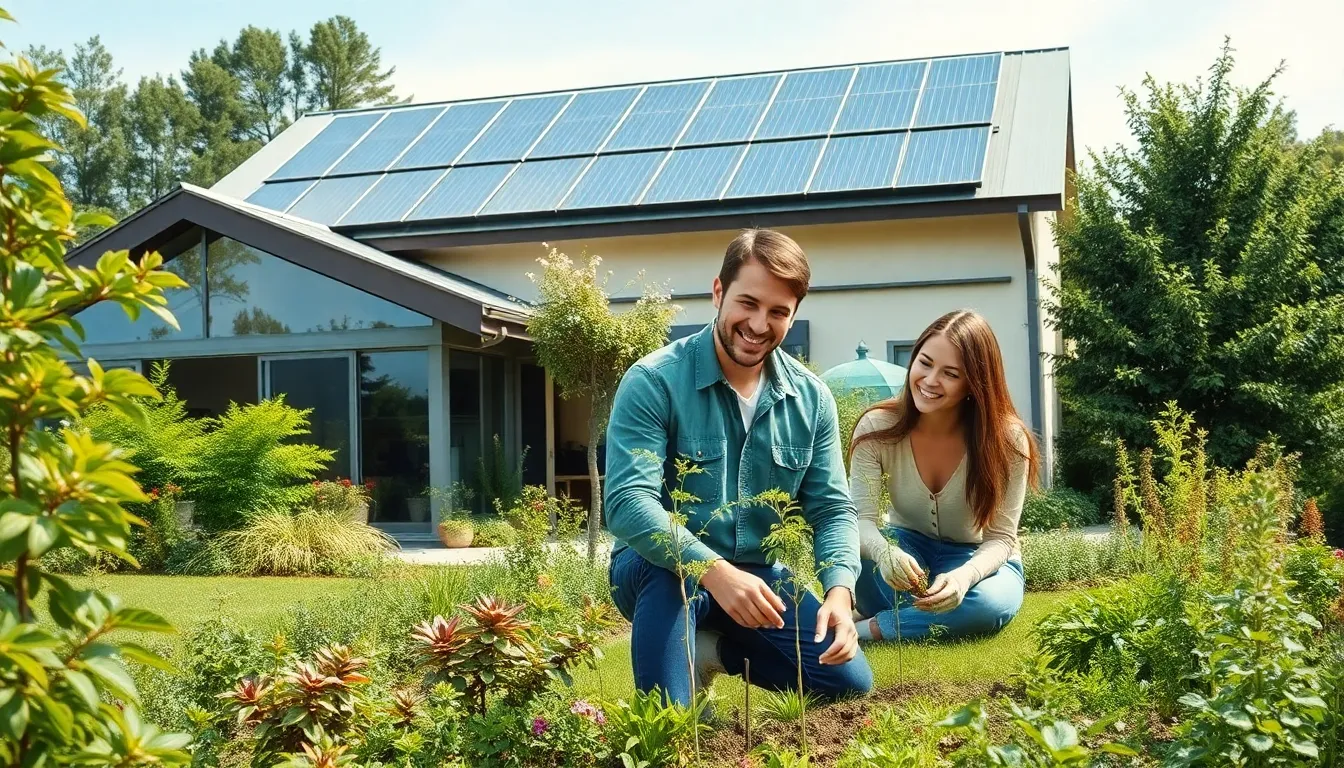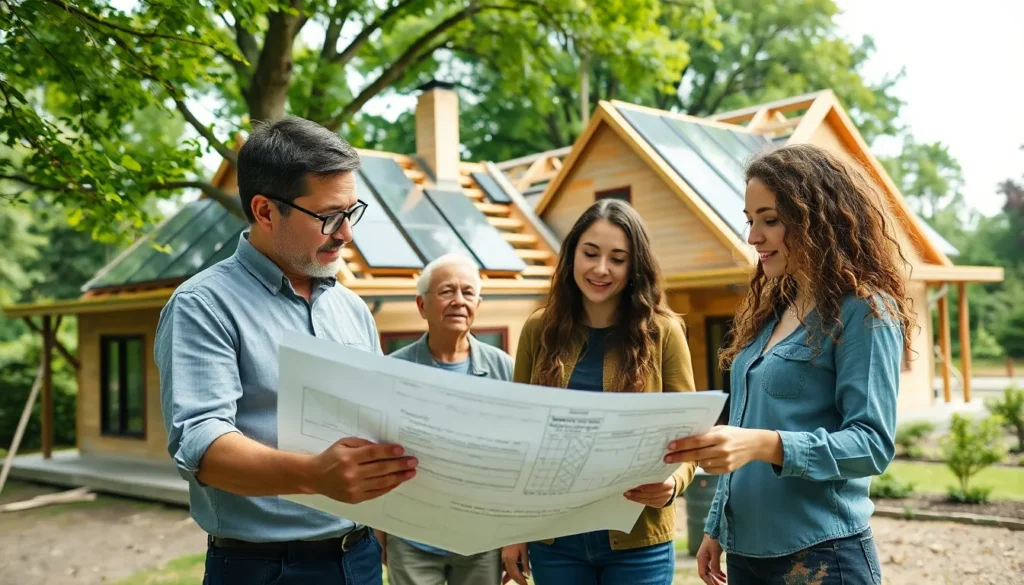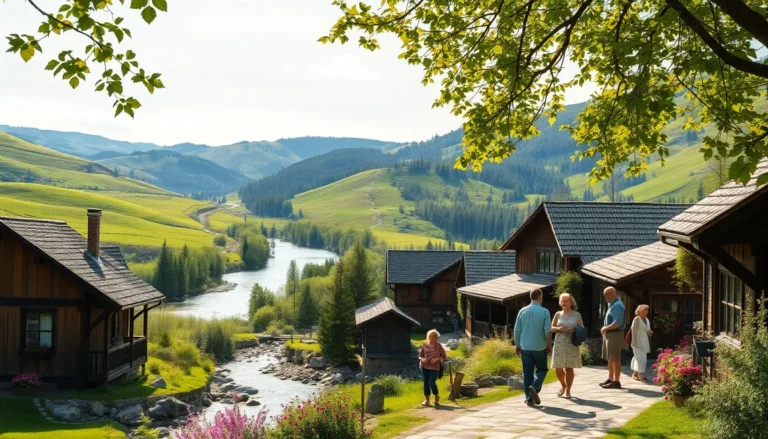In a world where the climate’s throwing tantrums and our planet’s begging for a breather, sustainable housing projects are stepping up like superheroes in capes. These eco-friendly abodes aren’t just about saving the whales or hugging trees; they’re redefining how we think about home sweet home. Imagine living in a place that not only shelters you but also gives Mother Earth a high-five.
Table of Contents
ToggleOverview of Sustainable Housing Projects
Sustainable housing projects encompass a range of initiatives designed to minimize environmental impact while enhancing livability. These projects integrate energy-efficient technologies, renewable materials, and sustainable building practices. Communities embrace eco-friendly designs that prioritize both nature and inhabitants.
Energy-efficient homes utilize advanced insulation, smart appliances, and renewable energy sources such as solar panels. These features significantly reduce utility costs and lower carbon footprints. Water conservation techniques like rainwater harvesting and greywater recycling further support sustainability.
Many projects focus on reducing reliance on fossil fuels, promoting electric vehicles, and integrating public transportation options. Urban landscapes incorporate green spaces, which enhance air quality and provide recreation for residents. These initiatives create healthier, more vibrant communities.
Additionally, sustainable housing promotes social equity by providing affordable living options. Diverse designs cater to various income levels and family sizes, enabling a wider range of residents to participate in eco-friendly living. Community engagement in the planning process ensures that projects reflect local needs and values.
Various certifications, such as LEED (Leadership in Energy and Environmental Design), validate the commitment to sustainability. These standards guide builders in implementing best practices and achieving measurable environmental goals. Clear metrics demonstrate the positive impacts of sustainable housing on residents and the surrounding ecosystems.
Prospects for sustainable housing projects remain bright, with increasing interest from governments, developers, and buyers. Innovations in technology and materials continue to advance the field, creating opportunities for more accessible and efficient homes. Integrating sustainable practices into housing development addresses the pressing challenges of climate change and urbanization, contributing to a healthier planet.
Key Features of Sustainable Housing

Sustainable housing incorporates various essential features that enhance both environmental performance and resident comfort. Key elements include energy efficiency and the use of sustainable materials.
Energy Efficiency
Energy efficiency forms a cornerstone of sustainable housing. Advanced insulation minimizes heat loss, allowing homes to maintain comfortable temperatures year-round. Smart appliances work alongside these energy-efficient designs, reducing energy consumption significantly. Incorporating renewable energy sources, such as solar panels, further decreases reliance on nonrenewable resources. This shift leads to substantial reductions in utility costs and carbon footprints, providing economic benefits alongside environmental responsibility.
Sustainable Materials
Sustainable materials play a vital role in constructing eco-friendly homes. Builders often select materials derived from renewable sources, minimizing environmental impact while promoting durability. Reclaimed wood and recycled steel commonly replace traditional construction materials, reducing waste and energy consumption during production. Locally sourced products offer additional benefits by lowering transportation emissions. Moreover, these sustainable alternatives enhance aesthetic appeal, creating living spaces that reflect modern environmental values while ensuring longevity and safety for occupants.
Types of Sustainable Housing Projects
Sustainable housing projects take many forms, each tailored to meet specific needs while minimizing environmental impact. The focus remains on innovative approaches that enhance both comfort and sustainability.
Single-Family Homes
Single-family homes integrate energy-efficient designs and eco-friendly materials. Homeowners benefit from advanced insulation systems that significantly reduce energy consumption. Incorporating solar panels allows residents to harness renewable energy. Many designs use sustainably sourced materials, like reclaimed wood, reducing the carbon footprint associated with new construction. Smart appliances minimize energy usage, leading to lower utility costs. Adopting water conservation practices, such as rainwater harvesting, ensures responsible use of resources. These features enhance both environmental responsibility and quality of life.
Multi-Family Units
Multi-family units exemplify sustainable living on a larger scale. These structures often feature shared resources, reducing individual energy consumption and promoting community interaction. Architects design spaces with green roofs and gardens, enhancing energy efficiency while improving air quality. Residents enjoy lower utility costs due to shared systems for heating and cooling. Materials used include recycled steel and bamboo, which lower environmental impact without sacrificing durability. Public transportation access supports reduced reliance on fossil fuels, further promoting sustainability. Community engagement plays a crucial role in multi-family developments, ensuring the needs of all residents are thoughtfully addressed.
Benefits of Sustainable Housing
Sustainable housing projects offer significant advantages for both the environment and economy. These benefits contribute to healthier lifestyles and more vibrant communities.
Environmental Impact
Sustainable housing greatly reduces carbon footprints. Energy-efficient technologies lower greenhouse gas emissions, while renewable resources like solar panels provide clean energy. Advanced insulation ensures optimal temperature control, decreasing heating and cooling demands. Water conservation techniques, such as greywater recycling and rainwater harvesting, promote responsible water use. These strategies support local ecosystems and biodiversity by minimizing land degradation. Communities with sustainable housing often feature green spaces that enhance air quality and provide recreational opportunities. This integration fosters a closer connection between residents and their natural surroundings.
Economic Advantages
Economic benefits accompany sustainable housing initiatives. Lower utility costs arise from energy-efficient appliances and smart home technologies. Homeowners enjoy long-term savings that enhance overall financial stability. Sustainable projects often increase property values, presenting attractive investments for buyers. Government incentives, such as tax credits and grants, further support affordability. Developers benefit from reduced costs due to using renewable materials and efficient construction methods. Communities adopting sustainable housing can attract businesses seeking environmentally responsible practices. Enhanced infrastructure incorporates public transportation options, fostering connectivity and convenience. Sustainable investments contribute to a resilient economy, ensuring long-term growth and stability.
Challenges in Implementing Sustainable Housing
Sustainable housing projects face several challenges that may hinder their successful implementation. Addressing these obstacles is vital for maximizing the benefits of eco-friendly housing.
Cost Considerations
High upfront costs often deter developers from pursuing sustainable housing. Initial investments in energy-efficient technologies, renewable materials, and sustainable construction practices can be substantial. Builders experience increased expenses when implementing advanced insulation and smart appliances. However, long-term cost savings through reduced utility bills and lower maintenance costs may counterbalance these initial investments. Additionally, incentives offered by governments can alleviate financial burdens, making sustainable options more appealing to developers.
Regulatory Hurdles
Navigating regulatory frameworks presents another challenge for sustainable housing projects. Complex zoning laws, building codes, and permitting processes can create delays. These hurdles often limit innovation in design and construction. Some areas may lack established guidelines for sustainable building practices, making compliance difficult. Collaboration among stakeholders, including local governments and community members, can help streamline processes and encourage more sustainable development. Prioritizing clear regulations can facilitate the growth of eco-friendly housing initiatives, paving the way for a greener future.
Sustainable housing projects represent a pivotal shift towards eco-friendly living. They not only address urgent environmental challenges but also enhance the quality of life for residents. By integrating energy-efficient technologies and sustainable materials, these homes foster a deeper connection between people and the planet.
As interest in sustainable living continues to grow, the potential for innovation in this sector remains limitless. Developers and communities can collaborate to create homes that are both affordable and environmentally responsible. Embracing sustainable housing is not just a trend; it’s a necessary step toward a healthier future for all.




